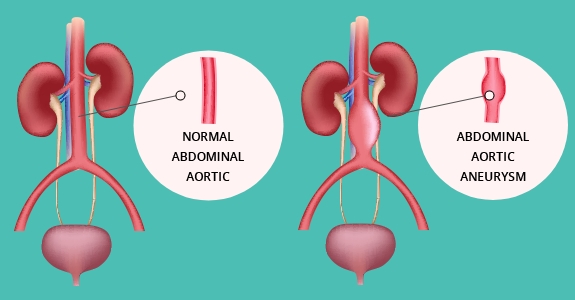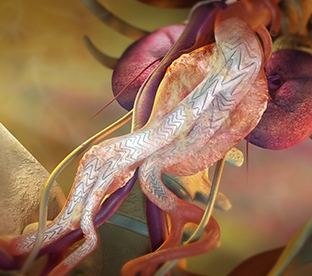An aneurysm is a dilation of a blood vessel and is a condition that can occur anywhere in the body. Some locations are more common than others and they cause different problems depending on which blood vessel is affected. The most common arteries affected are those in the brain, the aorta in the chest and abdomen, and the popliteal arteries in the legs. Aneurysms in the brain (intracranial aneurysms) are treated by neurosurgeons. Almost all others are managed by vascular surgeons.

Aortic Aneurysms
Aortic Aneurysms

Types of Aneurysms
Aortic Aneurysms - The aorta is the largest blood vessel in the body. It originates directly off the heart and travels through the chest into the abdomen before dividing into the right and left iliac arteries which then travel to the legs. When an aneurysm is in the chest, it is called a thoracic aortic aneurysm. Below the diaphragm, we refer to them as abdominal aortic aneurysms. Aortic aneurysms are readily treatable when detected early. Unfortunately, some go undiagnosed until they grow large enough to rupture; and if this occurs, the majority of patients will not survive. For this reason, Drs. Albright and Levin take a proactive approach in screening, surveillance, and treatment of aortic aneurysms.
Read on to learn a little more about risk factors, screening, and surveillance of aneurysmal disease or click below to learn how we treat them.
Thoracic aortic aneurysm (TAA) - Dilation of the aorta in the chest is called a thoracic aneurysm, the majority of which can be repaired minimally-invasively with a procedure known as TEVAR (Thoracic EndoVascular Aneurysm Repair). A large stent graft is inserted into the aorta from the femoral artery in the groin, similar to the insertion of cardiac stents, but on a larger scale. Historically, these aneurysms were repaired with very large incisions in the chest and required many days in the hospital, followed by months of rehab. TEVAR has revolutionized TAA treatment such that the majority of our patients are discharged the day following surgery.
Abdominal Aortic Aneurysm - The most common location for an aortic aneurysm is in the abdomen, below the renal arteries. In this location, they are called infrarenal aortic aneurysms. There are two options for treatment. Our physicians will recommend which option is
best for you based on several factors including your overall health and your specific anatomy.
Treatment for Aortic Aneurysms
Endovascular Aneurysm Repair (EVAR) - EVAR is a minimally-invasive approach in which a stent graft is inserted into the aorta through the femoral arteries in the groin. There is no major abdominal incision and in many cases, no incision is necessary at all to implant the graft. The stent extends from just below the renal arteries into the iliac arteries in the pelvis to effectively exclude the aneurysm from circulation. Because blood is directed through the stent, rather than into the aneurysm itself, the aneurysm will not expand. EVAR is usually performed under general anesthesia and most patients are able to go home the following day.
While EVAR is a very safe and effective way to treat an aneurysm, life-long follow-up is required. Our physicians follow Society for Vascular Surgery (SVS) surveillance guidelines. Generally, our patients will follow-up at least twice the first year after EVAR, and at least annually thereafter.
Risk Factors for aortic aneurysms
There are four main risk factors for developing an aortic aneurysm.
1. Smoking: Cigarette smoke contains hundreds of toxic chemicals, some of which damage the elastic tissue in the aortic wall. As the aorta loses elasticity, it is prone to forming an aneurysm. Smoking has also been shown to accelerate the rate of growth of aortic aneurysms.
2. Sex: Men are more likely to develop abdominal aortic aneurysms than women. Thoracic aneurysms affect men and women equally.
3. Age: Advanced age increases the likelihood of developing an aneurysm.
4. Family History: Genetics, or a history of aneurysms in the family, increases a patient’s risk of developing one themselves.
Who Should Be Screened for an Aortic Aneurysm?
Medicare will cover a screening exam [(AAA Screen) –link to non-invasive vascular lab AAA Screening] for men aged 65-75 who have smoked a total of 100 cigarettes or more in their lifetime.
Any person with a family history of aneurysms
How do we monitor patients with a small aneurysm?
Abdominal aortic aneurysms are frequently found during a screening exam or when imaging of the abdomen is obtained for other reasons. If a small aneurysm (one that is not large enough to warrant treatment) is found, the importance of routine surveillance cannot be overstated because aneurysms tend to enlarge over time. While there are many patient-specific factors we consider when determining a surveillance plan, generally, aortic aneurysms grow 2-3 millimeters per year; therefore the frequency and type of surveillance depends on the size of the aneurysm when it is initially discovered. In most cases, the threshold for repair is 5.5cm.
Aneurysm Size Follow-Up Interval Test
<3.0cm 3-5 years Ultrasound
3.0 -3.9cm 2-3 years Ultrasound
4.0-4.4cm 2 years Ultrasound
4.5 -4.9cm 1 year Ultrasound
5.0 – 5.4cm 6 months CT scan vs Ultrasound
5.5cm – Threshold for repair

